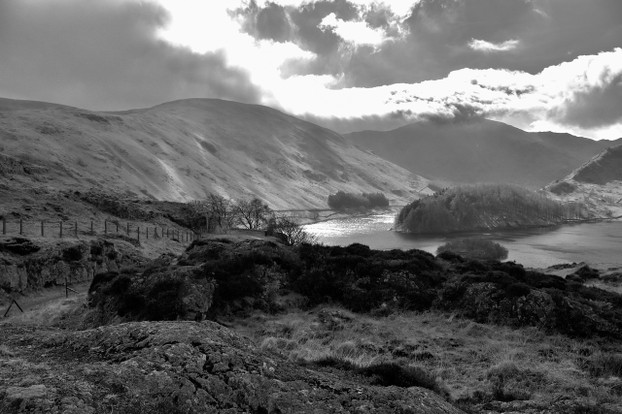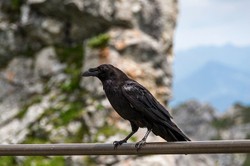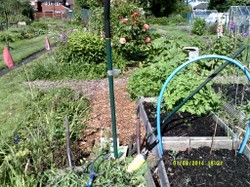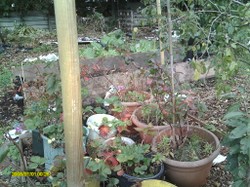A fell is a northern English dialect term for a hill derived from the Norse fjell. Hence the book deals with wildlife of the fells adjoining the large reservoir of Haweswater. The author takes his readers through a range of habitats in a hilly district that includes Montane heath, a landscape found atop mountains and the rarer Atlantic heath, composed of sphagnum moss overlying rock, which is found in small parts of the northern Lake District and is virtually impossible to walk on because of its softness.
He has an encyclopaedic knowledge of the flora of his northern abode and can recognise and discuss many plants, which makes this a book for readers keen on knowledge. He also has the physical capacity to raise across miles of countryside with his eyes open. This results in his finding rare specimens like Alpine flycatch, a rare insectivorous plant. But he was frustrated when he went across miles of fell to check on a rare species of pyramidal orchid only to find that it had been expertly dug up and stolen.The thief was no amateur plants man! As a bird warden he has a similar knowledge of wild birds, and the book details his efforts to create habitat for a variety of species now locally rare but once at home on the fells.
If there is any bird that he yearns to restore to the Haweswater area it is the golden eagle. These birds were once thriving, but widespread persecution led to their demise. Eventually in the early years of the twentieth century there were but two, a young male and a sadly elder female beyond egg laying age.so the eagle became locally extinct. So far, while they are doing better in Britain now they have not returned and they still have enemies who accuse them of killing lambs, though lamb taking is rare at worst and probably legendary.
Lee writes informatively and eloquently when he speaks of trips that he has undertaken as part of his job. One trip was a few weeks in South West Norway, which geologically resembles the geology of the Lake District though its land management seems more sophisticated than Britain's,, This gave him ideas for land, management in the UK. What also inspired him in Norway was how well the country compared with Britain in terms of its wild flower stock. He sake that the intensive production orientated land management in Britain is ecologically harmful and he decided to work for change.
Another journey was to the western Lake District to the wild Ennerdale project, where what is renowned as England's wildest Dale, reputedly, has become the nub of a great forest building project, as a redundant pinewood forest that was not economically viable to fell and sell was turned over to a native woodland in which cattle roamed semi wild. This showed him the scale of forest building that was achievable. A similar visit to Carrifran Forest in South West Scotland, which converted a tree less valley into a forest showed him the awesome capacity of committed volunteers for productive labour
.






 Pilgrimage. A reviewon 06/15/2025
Pilgrimage. A reviewon 06/15/2025
 Leo the Fourteenthon 05/09/2025
Leo the Fourteenthon 05/09/2025
 The Melsonby Hoardon 03/25/2025
The Melsonby Hoardon 03/25/2025



Comments
You Americans have impressive regulations. We have nothing like them. We could take a leaf out of America's book.
Hobby farms on this, western-pond side must be under 50 acres (20.23 hectares) and show profits never or no more often than one or two out of every five years. Their owners operate them as holiday and weekend homes for garden-, horse-, livestock-, poultry-loving extended- and nuclear-family members. Any products, such as farmers-marketable animals and crops solve no local, regional, national near-starvation and starvation.
Would that more or less describe hobby farming on your, eastern-pond side?
True, but some land is wasted. Take the example of hobby farms. Some farms are kept as rich people's playgrounds, when the country's need for food should necessitate their cultivation.
This isn't an excuse but is one of the reasons for intensive agriculture in the British Isles the limited amount of land available for cultivation?
The Norwegian fells are higher than the Lake District fells and they are richer florally than the British fells because intensive agriculture has not been practised there.
The first paragraph to your second subheading, The life of the Fells, links the English word fell with the Norse word fjell.
That subheading's fourth paragraph mentions a trip to southwest Norway because of the latter's geological resemblances to Lake District geology. That trip noted management practices and wildflower populations as nevertheless different from their counterparts in the British Isles.
Would there likewise be differences in how a fjell in Norway and a fell in the United Kingdom appear and function?
Very true.
Non-fiction books often surprise readers by their power. If well written by devoted explorers/travelers, they can provide immense inspiration. I also occasionally write an article about nature in one of our magazines.
At the battle of Hastings Saxons made every effort to kill William. Nobility were in danger on the battlefield. Killing an enemy nobleman was an achievement.
Feuding noblemen make me think of something I read about the Wars of the Roses.
Some sources on this, western-pond side mention that war as the first on your, eastern-pond side to orient battle strategy against as many enemy leaders, instead of as many enemy underlings, as possible. They note Warwick the Kingmaker (Richard Neville, 16th Earl, Nov. 22, 1428-April 14, 1471) as its noteworthiest implementer and practitioner.
And yet the subsequent William I oriented himself and his men against Harold the Fair as the number 1 target to be casualtized at the Battle of Hastings.
Were nobles and royals always vulnerable on battlefields or were they so only once Warwick the Kingmaker set it into motion or only when he was on the battlefield?